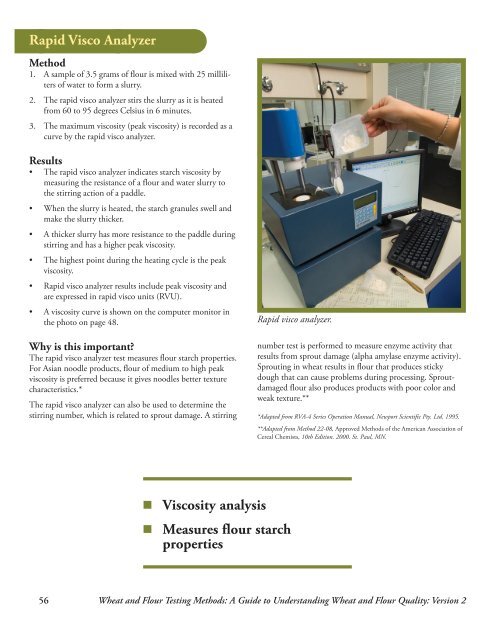Wheat and Flour Testing Methods - WHEATFLOURBOOK.ORG
Wheat and Flour Testing Methods - WHEATFLOURBOOK.ORG
Wheat and Flour Testing Methods - WHEATFLOURBOOK.ORG
You also want an ePaper? Increase the reach of your titles
YUMPU automatically turns print PDFs into web optimized ePapers that Google loves.
Rapid Visco Analyzer<br />
Method<br />
1. A sample of 3.5 grams of flour is mixed with 25 milliliters<br />
of water to form a slurry.<br />
2. The rapid visco analyzer stirs the slurry as it is heated<br />
from 60 to 95 degrees Celsius in 6 minutes.<br />
3. The maximum viscosity (peak viscosity) is recorded as a<br />
curve by the rapid visco analyzer.<br />
Results<br />
• The rapid visco analyzer indicates starch viscosity by<br />
measuring the resistance of a flour <strong>and</strong> water slurry to<br />
the stirring action of a paddle.<br />
• When the slurry is heated, the starch granules swell <strong>and</strong><br />
make the slurry thicker.<br />
• A thicker slurry has more resistance to the paddle during<br />
stirring <strong>and</strong> has a higher peak viscosity.<br />
• The highest point during the heating cycle is the peak<br />
viscosity.<br />
• Rapid visco analyzer results include peak viscosity <strong>and</strong><br />
are expressed in rapid visco units (RVU).<br />
• A viscosity curve is shown on the computer monitor in<br />
the photo on page 48.<br />
Why is this important?<br />
The rapid visco analyzer test measures flour starch properties.<br />
For Asian noodle products, flour of medium to high peak<br />
viscosity is preferred because it gives noodles better texture<br />
characteristics.*<br />
The rapid visco analyzer can also be used to determine the<br />
stirring number, which is related to sprout damage. A stirring<br />
n Viscosity analysis<br />
n Measures flour starch<br />
properties<br />
Rapid visco analyzer.<br />
number test is performed to measure enzyme activity that<br />
results from sprout damage (alpha amylase enzyme activity).<br />
Sprouting in wheat results in flour that produces sticky<br />
dough that can cause problems during processing. Sproutdamaged<br />
flour also produces products with poor color <strong>and</strong><br />
weak texture.**<br />
*Adapted from RVA-4 Series Operation Manual, Newport Scientific Pty. Ltd. 1995.<br />
**Adapted from Method 22-08, Approved <strong>Methods</strong> of the American Association of<br />
Cereal Chemists, 10th Edition. 2000. St. Paul, MN.<br />
<strong>Wheat</strong> <strong>and</strong> <strong>Flour</strong> <strong>Testing</strong> <strong>Methods</strong>: A Guide to Underst<strong>and</strong>ing <strong>Wheat</strong> <strong>and</strong> <strong>Flour</strong> Quality: Version 2


